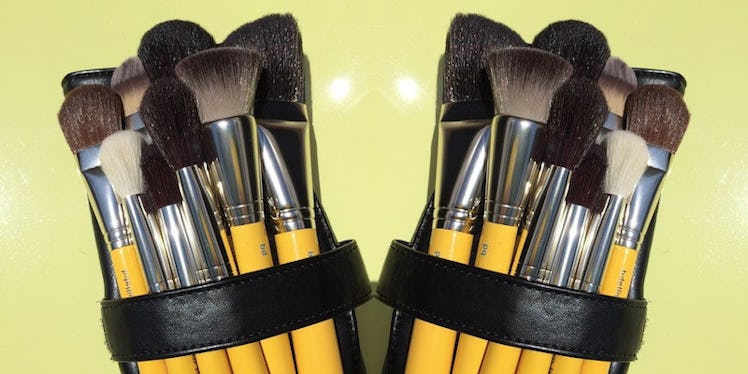
You Only Need 6 Makeup Brushes To Get By, And Here's How To Pick Them
There’s no such thing as a one-size-fits-all makeup brush.
These pretty, long-stemmed applicators are a lot like the group of friends you had in middle school: Each once serves a slightly different, nuanced purpose that’s pretty much unclear to everyone else.
Frankly, we usually just keep them in the wrapper for a year before throwing them out during spring cleaning.
Facing a cosmetic counter packed with brushes in dozens of shapes can leave us bewildered rather than curious to try something new. Caught between powder brushes so large they seem designed for giants and its curiously pointy alternatives, the average woman is right to feel lost.
With help from Sephora PRO Chris Sams, we’ve decoded the brush section of your local cosmetics store.
Basics, First
Before you begin your collection, remember that many of those special brushes are designed for professionals. Unless you’re drawing a liquid liner cat eye on Gisele Bundchen tomorrow, you don’t need 100 kinds of eye shadow applicators.
The magic number of brushes is six, according to Sams. Whether you jot it down or tattoo it on your bicep, never feel pressured to bring out your credit card for more than the basics.
The short shopping list includes a foundation brush, to apply your base layer evenly, and a concealer brush, good for blending out liquids or creams.
After the first two, pick up a blush brush. The handy tool can manage any formulation of bronzer, blush, highlighter and contour. In other words, it’s the one brush that should always sit in your to-go makeup bag for the gym or office.
Once your skin is covered, focus on smaller brushes for the areas around the eye. Here, your major purchases should be a flat, medium-sized shadow brush, a tapered blending brush and an angled tool for lining.
Reconsider your cosmetic strategy.
A non-professional tennis player doesn’t need to drop an entire paycheck on a racquet because they’re only using it casually.
In just the same way, Sams recommends reevaluating whether you’re a Serena Williams or a Tereza Smitkova (who?).
If you’re likely to try out eyeshadow weekly, spend your money on a set of well-made shadow brushes. In the long run, you'll save money by purchasing quality-made brushes once while avoiding maxing out your credit card on tools you don't use.
Always touch before you buy.
We willingly own up to having squirreled away several brushes from college, so attached to their sentimental value we’ve never given a thought to the fact that they make our skin blotchy and angry.
Sams doesn’t condone that kind of brush behavior, of course. Instead, he takes a two-pronged approach to purchasing, focusing on both bristle quality and construction.
According to him, dragging the brush across the skin is the easiest way to determine what you’re getting yourself into:
High quality brushes will not tug or drag, feel soft to the touch, and are well secured in the ferrule [base ring]. Give the bristles a gentle tug to make sure they will not shed.
Obviously, “gentle” is the key word here. We’re trying out brushes, not attempting to remove cheap extensions from our heads.
Know your bristles.
Ready to learn some lingo that’ll impress even your fanciest makeup-addict friends? Sams separates bristles into two categories: synthetic and natural hair. Deciding on your favorite type involves a bit of consideration.
Natural haired brushes usually come from goat, squirrel, sable or badger. The delicate fibers mean a better application of shadows, powders and the like. Conversely, synthetic haired brushes -- produced from man-made products like nylon -- work better with a product where more isn't necessarily better. Sams recommends them for the application of loose powder or highlighter.
However, the value isn't just in the bristles. Sams says it's how they're bound together that changes the quality of a brush:
High quality brushes are usually hand tied and secured to the handle with a metal ferrule, which prevents shedding and ensures the longevity of your brushes.
It's adorable when your kitten sheds, but not so much when it's a month-old brush. Examine the product before running to the register with it.
Don’t underestimate the importance of head.
All brushes are not created equal, no matter what the package might try and tell you. A broad, flat kabuki brush will always distribute bronzer better than a smaller, angled equivalent, so it's important to strategize when going in to purchase new brushes.
Consider, too, that faces come in a range of sizes.
Sams advises:
Tailor your brush choice to the size and shape of your eyes and face. Larger eyes require larger brushes and small eyes need smaller brushes.
A brush that's too big for the face will apply the product too heavily, making your delicate bronzed look seem more like an attempt at a Snooki Halloween costume.
Choosing wisely will result in better makeup application, less clutter and more money in your checking account. And that's a win all around.